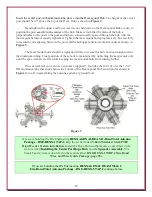
26
Final leveling and slight tension on the wires is accomplished by small, equal adjustments of the
wire guide stud clamp positions on the spreaders away from the center of the antenna. Too much
tension will distort the shape of the spreaders and slacken the other wire elements. This adjustment
process may take some time to get an acceptable balance between element tensions, but the goal is
to have all the wires horizontal, evenly spaced, with only slight tension to prevent antenna wires
from moving toward and away from each other in gentle breezes. The unique feature of the
“floating wire guides” will allow all of the spreaders and wires to move independently in strong
winds without causing undue stress, and then return to their natural position.
Remember, having tight wires will not improve performance - only appearance. A little slack is
better than too tight. This will eliminate stretching of the element wires and unnecessary tension on
the wire element ring terminals.
Perform final tightening of all spreader clamps, wire guide and rope attachment p-clamp hardware
and stud clamps. DO NOT over tighten these stainless steel element clamps. A modest tightening of
these small gear screws will accomplish sufficient hold.
If the optional Feedline Current Choke was not installed, connect a coaxial cable (RG-213 or
equivalent) feedline to the included double female SO-239 (UHF to UHF) adapter installed at the
end of the pigtail. If the optional Feedline Current Choke is installed, connect your coaxial cable
feedline (RG-213 or equivalent) to the bottom of the Feedline Current Choke. Use electrical tape to
hold the coaxial cable to the center post and to an extended mast, if used, above the rotator. Route
the coaxial cable around the rotator with the appropriate loop, as shown in the image on page 27,
using tape to secure the coaxial cable to the mast.
Installation on a Mast and
Rotator
The aluminum tube that holds the Fiberglass
Center Post is supplied with the Hexxagonal
Beam. This tube has an outside diameter of 1-
3/8" and may be used directly into a rotator.
When mounting the completed Hexxagonal
Beam on the customer supplied mast, use mast
or tubing that has an inside diameter of 1-3/8".
This mast could be 3 feet or 6 feet long
depending on your rotator specifications. When
using DX Engineering tubing, use two pieces
of .058" wall thickness tubes that are 1-1/2"
OD and 1-5/8" OD and nested together to give
you a thick wall mast that the 1-3/8" tube will
fit in.
Once mounted, the mast should be held to the Hexxagonal Beam tube by drilling one or two holes
and pinning as shown in the picture.







































